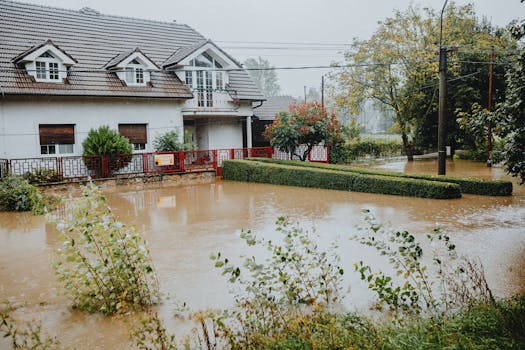Home Insurance
Understanding the True Value of Your Home Coverage
Unlock the real value of your home insurance. Learn ways to calculate, update, and optimize your home coverage value for real peace of mind. No missed steps—get covered.
Advertisement
Many people think of insurance as just another bill, but understanding the true home coverage value creates peace of mind and helps you protect what matters. Unexpected events can happen any time, and the right insurance policy means your financial future can stay on track.
Homeowners across the country face different risks: wildfires in California, hurricanes in Florida, frozen pipes in Minnesota. The scope of your home coverage value affects how quickly life returns to normal when disaster strikes. The difference is clear when repairs or replacements are urgent and expensive.
This article explains why your home coverage value matters and provides practical steps to ensure your property, possessions, and liabilities are properly shielded. Dive in for specific tools, examples, and expert advice you can use today.
Matching Insurance to Reality: Get Your Coverage Calculated Right
Reliable home coverage value results from blending precise facts about your property with up-to-date insurance limits. As a homeowner, you can match your actual needs with protections that fit your neighborhood, risks, and renovation history.
Set your coverage limits using today’s construction costs, not the original purchase price. Update your policy details after any major upgrade or structural change. The more accurate your info, the more solid your coverage.
Identifying Key Property Features
Walk through your home with pen and paper, noting foundation type, roof age, square footage, unique finishes, and upgrades. These characteristics shape your home coverage value, as insurers use them to calculate risk and replacement needs.
If your kitchen was remodeled in 2022, mention new cabinets and appliances. Include fence replacements, solar panels, or finished basements. Updated features may boost your home coverage value and get you better rates if properly recorded.
For condominiums, clarify which parts you own versus the association’s responsibility. This avoids gaps and ensures your own coverage matches real repair costs in case of fire, leak, or liability claims.
Gathering Accurate Cost Data
Contact local contractors for written estimates on rebuilding your home from scratch. Use their quotes to check that your home coverage value matches rising construction prices and regional labor rates.
Review the National Association of Home Builders’ reports or cost calculators from leading associations. Compare costs for similar homes in your area to avoid underinsuring or grossly overpaying for extra coverage you don’t need.
Keep a folder with receipts, invoices, and photos. This record helps validate your home coverage value, especially if a major claim requires you to prove your damages for fast payments.
| Feature | Replacement Estimate | Coverage Needed | Action Step |
|---|---|---|---|
| Kitchen Remodel | $35,000 | Update after renovation | Submit receipts and photos to insurer |
| Roof Replacement | $14,000 | Verify with new policy | Add updated roof info in your file |
| Added Living Space | $80/ft² | Recalculate total square footage | Send building permit to agent |
| Solar Panel System | $22,000 | Request green add-on endorsement | Ask agent about specific discounts |
| Hardwood Flooring | $9,000 | Include in replacement value | Photograph each finished room |
Safeguarding Possessions: Know What’s Covered — and What’s Not
Knowing your home coverage value gives a clear view of how your policy shields valuables and personal items. Your coverage may set limits for jewelry, electronics, or collectibles. Review those specifics and shape your decisions accordingly.
Every policy contains exclusions and special item limits. Read through your declarations page for columns marked ‘sub-limits’ or ‘special coverage’ — these reveal what might not be fully protected under your base policy.
Inventorying Belongings Makes Claims Smoother
Create a complete home inventory, listing everything from furniture to electronics. The more details you record, the easier it is to document losses during a claim.
Snap clear photos and save digital receipts where possible. Store a backup copy in the cloud—if disaster hits, you’ll access proof of ownership quickly.
- Walk through each room once per year, noting serial numbers and values to maintain current coverage.
- Keep a running list for new purchases and gifts—don’t leave items off your inventory just because they’re recent.
- Record upgrades like artwork, rare books, or home theater systems with a price estimate.
- Add seasonal gear (bikes, ski equipment, patio furniture) so your home coverage value rises to match new acquisitions.
- Share updates with your insurance agent after each significant purchase.
Revisit your coverage levels every year to see if your home coverage value truly matches your updated possession inventory. Adjust as necessary to close any gaps.
Understanding Exclusions and Special Coverage
Policies spell out what isn’t covered in detailed endorsements or lists. Read for phrases like ‘water back-up,’ ‘earth movement,’ or ‘wear and tear’—these signal coverage limits or outright exclusions.
If you own musical instruments or expensive hobby gear, call your insurer to ask, “Is my home coverage value enough if I lose my drum set due to a basement flood?”
- Review your policy annually for changes to exclusion lists—regulations or insurer policies sometimes shift, creating new gaps.
- Add endorsements for jewelry, collectibles, or business equipment stored at home to increase protection.
- Be clear: flood and earthquake damage need separate policies in most areas—ask for an explanation based on your zip code.
- Never assume home coverage value includes rideshare vehicles, boats, or backyard structures. Specify each item and check for limits.
- Reach out to your agent after buying new electronics or tools valued over $1,500 to confirm adequate coverage.
By proactively checking these special items, your home coverage value will remain strong—no surprises if you need to make a claim.
Evaluating Liabilities: Expanding Coverage for Peace of Mind
Strengthening your home coverage value often means looking beyond fire and theft. If a guest gets injured or your child’s baseball breaks a neighbor’s window, your liability coverage pays for repairs and legal help.
Homeowners benefit from understanding liability rules and making sure their protection limits reflect today’s legal and medical costs—typically higher than most initial policy settings.
Umbrella Policies Add a Safety Net
Step up your liability protection by purchasing a personal umbrella policy. This increases your home coverage value, covering large lawsuits or medical bills after accidents.
An agent might suggest, “For $250 a year, you get $1 million in extra coverage.” This option is particularly useful for dog owners, pool owners, or people who regularly host guests.
Umbrella policies kick in when your regular policy caps out. They bridge the gap, preventing major out-of-pocket costs if things go wrong in ways your standard policy didn’t foresee.
Setting Liability Limits Strategically
Most policies default to $100,000 or $300,000 in liability coverage. Ask your agent: “What home coverage value do I need if my net worth is higher or I have unique risks?”
If you own a trampoline, entertain frequently, or rent out space through vacation apps, consider raising your limit. Legal fees escalate quickly; higher coverage provides extra stability in high-stress moments.
Factor in medical costs for injuries and replacement value for damaged property. Confirm every family member is named on your policy to ensure full liability protection at all times.
Pricing and Value: Balancing Premiums with Adequate Protection
Calculating home coverage value involves more than picking the lowest premium. Balancing cost and benefit requires seeing insurance as an investment in resilience rather than a simple expense.
Request several quotes from different providers, making sure they all use true replacement cost rather than depreciated cash value. Compare rates, but always weigh what’s covered line by line.
Factoring in Deductibles
Select a deductible that matches your willingness to pay out-of-pocket in a claim. A higher deductible lowers your annual rate but increases risk when disaster strikes. Weigh your emergency savings against possible costs.
A homeowner might say, “I’m comfortable with a $2,500 deductible because my savings can handle most minor emergencies, but I want strong protection for catastrophic losses.”
If budget is tight, look for smart tradeoffs: increase home security or upgrade wiring for discounts, instead of slashing coverage limits and risking future hardship.
Discounts and Incentives for Policyholders
Bundling home and auto policies often nets a 10–20% savings and can raise your home coverage value through combined loyalty features.
Ask for discounts if you have monitored alarms, fire sprinklers, or live in a gated community. Each system you install both boosts safety and reduces your cost long-term.
Always review your provider’s renewal offers for new discounts. Send in documentation after new security upgrades so your home coverage value is recognized in potential savings.
Review Schedules and Triggers: When to Update Your Policy
Staying current with your home coverage value means checking your policy after every major life change: marriage, renovations, new items, or neighborhood risks.
Set a recurring calendar reminder—at least once a year—to review limits and endorsements. Immediate updates after big events prevent gaps and keep your financial safety net strong.
Major Life Events: What to Watch For
Birth of a child, inheritance, or changing jobs can all increase what you own or your potential liability, impacting your home coverage value. Update your agent quickly about new risks.
Remodeling projects almost always affect your coverage calculations. Share contractor quotes, before-and-after photos, and final costs to get policy limits raised in real time.
If you buy a new car, sell expensive gear, or host a wedding at home, touch base with your insurer. They’ll recommend updated limits and suggest new endorsements if appropriate.
Neighborhood and Environmental Changes
If wildfire risk increases or flood maps are redrawn for your area, your home coverage value assessment needs refreshing. Local construction or infrastructure improvements can reduce risks, affecting your premiums and limits.
Stay aware of major regional insurance changes—some companies adjust based on local weather, crime, or building code shifts. Periodically, ask, “What local changes affect my home coverage value this year?”
When a neighbor suffers a roof fire or large theft, see it as a trigger to revisit your policy details. It’s smoother to adjust before disaster strikes at home.
Claim Processes: Strategies for Getting the Most from Your Policy
Securing your home coverage value at claim time means acting quickly and organizing detailed evidence. The smoother your claim, the faster you’ll resume life after a loss.
Document everything: take clear photos of the incident, write down exactly what happened, and call your insurance company quickly. Use their claim checklists to guide you through each step with confidence.
Following a Filing Sequence
File your claim as soon as possible after damage or loss—delays can slow down payments or even reduce your coverage benefits.
Submit estimates, receipts, and photos along with a concise, factual description. A good script: “The hailstorm caused 13 roof shingles to break and two windows to shatter. Here’s my dated receipts and repair quotes.”
Follow up regularly for updates. Keep every piece of correspondence organized. This helps both you and the insurer if the claim process stretches beyond a few weeks.
Avoiding Common Pitfalls
Never start clean-up or repairs before an adjuster inspects the damage, unless your insurer directs you for safety reasons. Doing so can limit how much is reimbursed.
Ask for written explanations if your claim is delayed or denied. Use the phrase: “Can you show me where this is explained in my home coverage value documents?”
Rebuild your files after a claim. Update your inventory, check for premium changes, and review your policy to address new or unexpected questions regarding coverage for next time.
Putting Home Coverage Value Lessons to Work Moving Forward
Assess your home coverage value as a living, evolving safeguard—not a fixed bill. Each update makes your insurance a stronger shield for your home, your possessions, and your finances.
Keep personalized notes, receipts, and photos organized. Make it your habit to talk with your agent after every life event or home improvement, so your coverage is always current and ready.
Future-proof your household’s protection by reviewing your home coverage value annually. These regular check-ins let you relax, knowing that whatever happens, your safety net stands strong and your recovery will be smooth.





